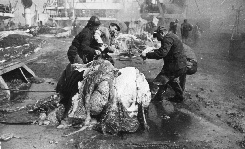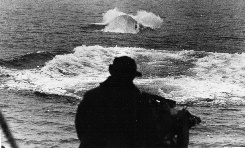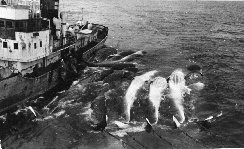 |
|||||||||||||||
|
|
|||||||||||||||
|
|||||||||||||||
|
|
|||||||||||||||
|
Commercial
whaling - a brief history
|
 |
|||||||||||||||
|
|
|||||||||||||||
|
|||||||||||||||
|
|
|||||||||||||||
|
Commercial
whaling - a brief history
|
|
Traditional whaling |
|
Men have hunted whales for thousands of years. Ancient American Indian and Eskimo stories, passed down by word of mouth, tell of how hunters butchered whales which were stranded in low water by the tide and storms. In indigenous coastal populations, the ability to hunt, kill and land a whale has won many a hunter the respect and thanks of his tribe. Traditional subsistence whaling was a dangerous affair, the whale being killed by a harpoon or long knives, placed by a hunter in an open boat. It was not uncommon for a whale to capsize the boat, throwing the hunters towards a certain death in the icy waters. |
|
In some parts of the world - including Japan, Alaska, Canada, Greenland and the Faroe Islands, indigenous people still carry out their subsistence whaling. Their hunt is not commercial, it is protected by international law as an indigenous hunt, and their activities are deemed by the International Whaling Commission as not being a threat to the particular whale populations on which the hunt is based. Whilst some of the hunting tools and methods of the indigenous subsistence whalers have remained unchanged for generations, some technical developments have occurred since the first contact with merchant whalers during the last century. |
|
This programme does not seek to describe, debate or criticise traditional subsistence whaling by indigenous peoples. The existence of such traditional whaling, and its legality under international regulations is a matter of record which is not under question in this programme. |
|
Commercial whaling |
|
Already in medieval times, mariners had hunted the great whales(1), and by the 1600's and early 1700's, merchant shipowners recognised the commercial potential of whaling - whale oil for lamps, baleen for tools, clothing and ornaments, the meat for food. In its methodology, their hunt resembled the whaling of indigenous peoples - striking with a harpoon from an open rowboat, and butchering the whale in the water, alongside the ship. But their activities were limited to regions where whales could be caught and butchered and transported home easily - around the coast of Greenland, of the coast of Labrador and Norway. Whalers from the east coast of America - at this time still a British colony, sold their whale products to England and the colonies. By the outbreak of the War of Independence in 1775, whaling had become one of the colony's most important sources of credit in England. |
|
Whaling was one of the first large-scale organised enterprises in Europe. The market for whale oil began to be developed as early as in the 12th century by the Basques who caught right whales (Greenland whales and black right whales) in the Bay of Biscay. In the 16th and 17th centuries, the industry was dominated by wealthy English and Dutch interests, hunting in the Arctic Ocean and along the coasts of Norway, Spitzbergen (Svalbard), Greenland and Newfoundland. The investments and risks involved were enormous, but so were the potential profits. The stocks of right whales were depleted. The great stocks of blue whales, finbacks and sei whales, though, were safe as long as the whalers only used hand harpoons and sailing ships.(2) |
|
Not all whale migration routes lay close to land - many whales spend most of their lives far out in the ocean. Hunting these whales could only become economically viable, with bigger ships and other hunting and butchering methods. Several developments made this possible. |
|
The first development was the shipboard tryworks - large iron pots set in brick built ovens on the deck of the whaling vessel. With the tryworks whalers could render blubber to oil at sea, saving valuable cargo space. |
|
Another development was the production of candles from spermaceti - the waxy substance found in the head of the sperm whale. This development in 1748 brought the focus of American industry onto the sperm whale. |
|
A new maritime industry was born, and just like gold, oil and construction a century or more later, whaling attracted many men, whose pursuit of the whale was a pursuit of wealth and adventure. The whaling grounds grew each year, the shipowners pushing their vessels and men further out into the oceans and further north into the Arctic. |
|
Another development, which came a century later, was the brainchild of Norwegian shipowner Sven Foyn, from the village of Tønsberg. |
|
In 1847 Svend Foyn sent his seal hunting vessel "Haabet" (Hope) north into the Polar sea. Many other sealing ships followed suit, and the hunting was profitable for a number of years. However, by the 1860's Sven Foyn had decided that competition in the sealing industry was too hard, and examining new opportunities, he turned his attention to whaling. In 1863 he built his first steam-powered whaling ship "Sped & Fides", which included a bow-mounted harpoon cannon which could fire explosive harpoon charges. He patented his new invention, securing a virtual monopoly on the ocean based "great-whale" hunts for the following 10 years. When Sven Foyn died in 1894, he was the richest man in Tønsberg. |
|
Up to his death, Sven Foyn remained the visionary shipowner. Just before his death, he sent an expedition to the South Polar Sea to research the commercial whaling potential of these hitherto almost unexploited waters. The expedition found many whales - blue, fin, sei and sperm whales - and within a few years, several Norwegian shipowners established whaling stations on the British island of South Georgia. |
|
The Norwegians were slow to adopt ocean-going factory ships as the basis for their whaling, preferring for many years the method of catching whales and bringing them, whole or partially butchered, to on-shore whaling stations for processing. |
|
But by the 1920's the Norwegians had recognised the limitations of shore-based whaling, partly because operation of their whaling stations was dependent on the goodwill and taxation policy of the host nation. With the advent of steam, it was now possible for Norwegian whalers to operate for many months without going in to harbour.  This
new way of whaling - called "pelagic" whaling (after pelagic fish and marine
mammals which spend their lives in the open oceans) involved massive floating
processing vessels equipped with ramps on which an entire whale could be
hauled up onto the deck for butchering. Butchering was accomplished
by butchering crews, with the aid of machinery. The blubber could be rendered
to oil in modern tryworks, and the baleen stored in the hold. Blubber and
baleen remained the most important products. The rendered oil was a valuable
commodity back in Europe, where despite the advent of gas and electric
lighting, it was still in demand as a raw-material for foodstuff-fat products
such as margarine, for the manufacture of soap, as a softener in the production
of hemp and sisal rope, as a hardener in steel manufacture, and in
the production of textile dyes. This
new way of whaling - called "pelagic" whaling (after pelagic fish and marine
mammals which spend their lives in the open oceans) involved massive floating
processing vessels equipped with ramps on which an entire whale could be
hauled up onto the deck for butchering. Butchering was accomplished
by butchering crews, with the aid of machinery. The blubber could be rendered
to oil in modern tryworks, and the baleen stored in the hold. Blubber and
baleen remained the most important products. The rendered oil was a valuable
commodity back in Europe, where despite the advent of gas and electric
lighting, it was still in demand as a raw-material for foodstuff-fat products
such as margarine, for the manufacture of soap, as a softener in the production
of hemp and sisal rope, as a hardener in steel manufacture, and in
the production of textile dyes. |
 The
processing vessel did not hunt whales, instead it was the "mother vessel"
for a fleet of typically 8 - 12 smaller harpoon ships, which pursued and
caught the whales and brought them to the factory vessel for processing. The
processing vessel did not hunt whales, instead it was the "mother vessel"
for a fleet of typically 8 - 12 smaller harpoon ships, which pursued and
caught the whales and brought them to the factory vessel for processing. |
|
The whaling shipowners of Tønsberg retained a prominent position amongst the Norwegian pelagic whalers, though they were soon joined by serious competition from the Norwegian town of Sandefjord . In 1928 three shipowners - Anders Jahre, Anton von der Linde and Sven Foyn Bruun established three whaling companies - Kosmos, Pelagos and Antarctic. The latter two companies and their fleets were operated out of Tønsberg, whilst the former - Kosmos - was operated out of Sandefjord by Anders Jahre. |
|
There were other Norwegian shipowners operating in the South Polar Sea, including the "Hector" and "Victor" fleets which sailed under the British flag in a joint venture with the British Union Whaling company. |
|
All in all, this development heralded an era of industrial whaling so efficient, that it in the course of a few decades would bring the great whales of the Antarctic - the largest whale populations on earth - to the verge of extinction. |
 In
1920 8,273 whales - mostly great whales - were caught in the South Polar
seas around South Georgia and South Shetland - 3,425 by the Norwegian fleets,
who in the same year landed a total of 4,590 whales - again mostly great
whales - world wide. Norway owned and operated the most productive whaling
fleets in the world, accounting for over 40% of the worlds commercial whaling
catch.(3) In
1920 8,273 whales - mostly great whales - were caught in the South Polar
seas around South Georgia and South Shetland - 3,425 by the Norwegian fleets,
who in the same year landed a total of 4,590 whales - again mostly great
whales - world wide. Norway owned and operated the most productive whaling
fleets in the world, accounting for over 40% of the worlds commercial whaling
catch.(3) |
|
At commercial whaling's peak in 1962, Norway landed 9,375 of the total of 38,555 whales caught in the South Polar seas, with Norway's world wide catch of 9,681 whales accounting for 15% of the worldwide catch of 66,026 whales.(4) This was not due to any reduction in Norwegian whaling, rather the expansion of the international whaling industry, as new whaling nations had joined the hunt. |
|
Although commercial whaling only reached its peak in 1962, prior to the cessation of whaling in the seas around Antarctica which took effect in 1964, the international community had known for 15 years that the whaling industry was challenging a finite natural resource. |
 Along
with the British, the Norwegians were quick to turn the "finite resource"
issue to their advantage, as an argument to prevent other nations joining
their profitable enterprise in Antarctica. As the potential effects of
commercial whaling in the great whale populations of the Antarctic became
evident in the years just after the Second World War, Norway and Britain
established their own quota system for whaling in the southern polar seas.
Whilst giving British and Norwegian whaling an air of legitimacy, the quota
system was also intended to keep other nations out of the Antarctic. Along
with the British, the Norwegians were quick to turn the "finite resource"
issue to their advantage, as an argument to prevent other nations joining
their profitable enterprise in Antarctica. As the potential effects of
commercial whaling in the great whale populations of the Antarctic became
evident in the years just after the Second World War, Norway and Britain
established their own quota system for whaling in the southern polar seas.
Whilst giving British and Norwegian whaling an air of legitimacy, the quota
system was also intended to keep other nations out of the Antarctic. |
|
In 1946, the world's whaling nations met to discuss their whaling interests, and with the passing of the "International Convention for the Regulation of Whaling" the International Whaling Commission was formed. Norway was not a signatory of the 1946 convention resolution, but did ratify the resolution along with the other original member nations in November 1948. |
|
At the time of its inception, the commission was primarily intended to protect the commercial whaling interests of the member nations. The 1946 convention articles had the purpose of concluding a "convention to provide for the proper conservation of whale stocks and thus make possible the orderly development of the whaling industry".(5) |
|
It would be some years before scientific enlightenment, coupled with a rising public awareness of the extent to which commercial whaling harvests exceeded levels under which whale populations were threatened, would temper the priorities of the IWC, making it a forum for international whale conservation. |
 In
the meantime the Norwegians continued to hunt whales in the Antarctic -
accompanied by many other nations. Whilst the businessmen shipowners and
whale produce consumers - like the soap manufacturer Unilever who virtually
controlled the market for whale produce to the household chemical industry
- may have recognised that given time, political and environmental considerations
would bring an end to this era, most participants - whaling crews, mariners,
factory ship workers - had little idea that their livelihood had its dark
side. As yet, there was little public concern, limited scientific research,
and whale conservation had little or no political attraction. In
the meantime the Norwegians continued to hunt whales in the Antarctic -
accompanied by many other nations. Whilst the businessmen shipowners and
whale produce consumers - like the soap manufacturer Unilever who virtually
controlled the market for whale produce to the household chemical industry
- may have recognised that given time, political and environmental considerations
would bring an end to this era, most participants - whaling crews, mariners,
factory ship workers - had little idea that their livelihood had its dark
side. As yet, there was little public concern, limited scientific research,
and whale conservation had little or no political attraction. |
|
For most of the whalers, whaling was a way of life - like fishing or agriculture. It had its own culture and traditions, which many a whaler from coastal Norway was born into. Sons followed their fathers to sea, accepting whaling as their way of life. This was perhaps especially true of Norwegians, who had a long tradition of whaling in the waters off the coast of northern Norway. For communities such as Tønsberg and Sandefjord, whaling had been the foundation of the local economy for several generations. Like the Japanese, who also had whaled locally for centuries, whaling for the Norwegians was not just a commercial - almost colonial - activity practised overseas, it was in their blood. |
| Many factors played their part in the end of commercial whaling in the Antarctic waters. |
|
As the world recovered from World War 2, the worldwide shortage of fat-stuffs - for food production, soaps and other industrial processes - eased as the agricultural industry recovered. New, cheaper alternatives such as rape seed oil, palm oil and coconut oil reduced industry's hitherto dependence on whale oil. Similarly, rubber and plastics had already begun to offer alternatives to baleen, which was no longer such a vital bi-product of whaling. |
|
Whilst nations with a local whaling tradition had some market for whale meat, it was not a food product which had great commercial potential in non-whaling countries. This is despite the fact that whale meat is rich in protein, low in saturated fats, and when prepared properly, has a taste comparable to fine beef. Whale meat for human consumption had never been especially profitable, some meat was brought to land and processed as animal fodder or agricultural fertiliser, whilst much of the whale meat was cast overboard during the butchering process. (This is shown in the footage of the 1948/49 Norwegian voyage). |
|
Following the establishment of the IWC, the scientific community began to show a serious interest in whales. Though census methods in the early years were (and in many cases still are) unreliable, the scientific studies necessary to support quota negotiations between IWC members soon indicated that the present catch levels were dangerously high. And as more nations joined the IWC and participated in the Antarctic harvests, the need for regulation became evident. Norway's prominent - and profitable - position in the southern polar seas was no longer sacred. The economics of whaling would eventually collapse. |
|
The fleets of the major whaling nations were becoming older. Most vessels were built before the war, some were still steam powered. Years of voyaging in the harsh Antarctic waters had taken its toll on these vessels, and yet the economic prospects in the fifties and early sixties hardly inspired shipowners to invest in building new fleets. |
|
For shipowners like Anders Jahre, it was a matter of economics - to continue whaling with existing ships until history said it was time to stop. To harvest as many whales as possible, whilst there was still the opportunity and the marketplace. |
|
Whaling in the Antarctic reached its peak in 1962, following which the IWC introduced stricter and smaller quotas. From the winter season of 1964, the IWC introduced a ban on catching the blue whale in Antarctic waters. Norway and Japan complied, whilst USSR took 20 whales. |
|
By the mid to late sixties, whaling and the fate of the great whales was becoming a public issue, and a series of protest organisations with environmental or animal welfare platforms adopted the whale's cause. Sea mammals - particularly whales and seals, proved to be "sexy" - symbols of the natural world which were eminently suitable for mobilising public opinion. By the mid seventies most nations had a considerable "Save the whale" lobby. |
|
In 1982, the IWC agreed on a total international ban on commercial whaling. Canada walked out of the IWC in protest, and has not yet rejoined. Iceland took a similar stand in 1992. Today, two of the countries in the Northern hemisphere with long traditions for whaling remain outside the IWC. |
|
The IWC has achieved a drastic reduction in commercial whaling worldwide, though not without considerable differences of opinion between member states. Japan continues to hunt whales in the southern hemisphere for ostensibly scientific purposes. Norway, whose long tradition for whaling in home waters was almost extinguished by zero quotas, decided in 1993 to continue hunting minke whale under the IWC protest clause, whereby member nations can lodge a protest and continue or resume whaling whilst the commission attempts to resolve the issue. As yet, this issue remains unresolved. |
|
The advent of the IWC brought about a growing understanding of the whale's place in the natural environment and marine food chain. Scientific research of cetaceans and their habitat continues to grow, though there remain many unanswered questions. Arriving at reliable population counts is still a difficult discipline, as whales spend most of their lives under water. Many whales are still only superficially understood, their reproduction cycle, life expectancy, breeding rate, food and energy consumption remains a mystery which will only gradually become unravelled. |
|
But the sheer inadequacy of science to answer all questions today has taught mankind to treat questions about whaling very conservatively, giving the whale, rather than the whaler, the benefit of the doubt. |
|
Most of the world's remaining whale hunts are undertaken by indigenous peoples, their whaling regulated strictly according to international agreements about strike and kill quotas, hunting methods and weapons, and hunting seasons. It is in these communities that the art of whaling was first mastered by mankind, and it is here that some of the world's most advanced cetacean studies are undertaken today. |
|
And the great whales of the Antarctic? They are now protected - in 1994 the International Whaling Commission established the Southern Ocean Sanctuary in the waters around Antarctica , The pelagic fleets, with their factory ships and harpoon escorts no longer ply these waters, some are laid up in remote harbours around the world, the rest have been broken up for scrap. |
|
Only a few surviving whalers, in their seventies at least, remain to tell the story - Fut Jensen has left us, but his film remains, and will soon be seen. |
| Footnotes to this page |
| 1. The Blue whale (Balaenoptera musculus), Humpback whale (Megaptera novaeangliae), Fin Whale (Balaenoptera physalus), Sei whale (Balaenoptera borealis) and Sperm Whale (Physeter macrocephalus) are commonly referred to as "The Great Whales" The term includes other whales - Greenland right whale or Bowhead (Balaena mysticetus), North Atlantic right whale (Eubalaena glacialis), North Pacific right whale (Eubalaena sieboldii), Southern right whale (Eubalaena australis), Gray whale (Eschrichtius robustus), Bryde's whale (Balaenoptera edeni), Minke whale (Balaenoptera acutorostrata). All but the Humpback and the Sperm whale are baleen whales. The Sperm whale is the largest toothed whale. |
| 2. The High North Alliance brochure; "LIVING OFF THE SEA, Minke Whaling in the North East Atlantic", February 1994. |
| 3. The Committee for Whaling Statistics, "International Whaling Statistics - XLVII", Oslo, 1962 http://www.luna.pos.to/sta_1920.html see statistics here |
| 4. The Committee for Whaling Statistics, "International Whaling Statistics - XLVII", Oslo, 1962 http://www.luna.pos.to/sta_1962.html see statistics here |
| 5. INTERNATIONAL CONVENTION FOR THE REGULATION OF WHALING, 1946 signed at Washington, 2 December 1946 and its PROTOCOL signed at Washington, 19 November 1956 ( © IWC ) |
|
|